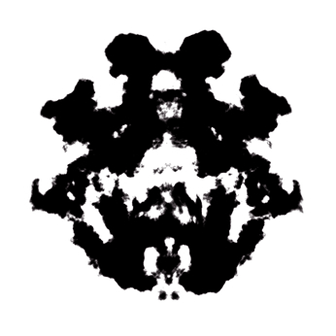Ink Blot Psychology and Unique Scoring Systems
Originally the Inkblot psychology was used to study imagination processes and other functions of your brain. However, Hermann Rorschach used inkblot pictures for the first time to measure your underlying personality traits, fears, anxiety, and thoughts.
He created Rorschach images by dribbling ink on white sheets of paper and folding them in half. You may experiment the same way to generate your own relatively symmetrical inkblot pictures.
Unfortunately, Rorschach couldn’t survive to mature his projective techniques, and much was left with his followers. Now ten inkblot pictures are used to measure your subconscious. Five of them are prepared in shades of gray and black colors, two in bright red and the remaining in combination of different colors.
Ink Blot Psychology in Action
In a real testing session, the tester shows you inkblot pictures one by one. He asks you to respond for the image. Whatever you say becomes part of his notebook.
He also notes down your reaction time, position in which you hold a card, your spontaneous reactions, and emotional expressions. He may even ask you questions about the parts and aspects of each of the ink blot picture.
The test proceeds in a very leisurely pace. The examiners expect that you may give one or more responses. You may even reject a card without telling any reason.
In most of the cases, you are given an opportunity to correct your responses previously given. But that change shall also play an important role in analyzing your inner self.
Scoring System of the Ink Blot Psychology

Rorschach images were initially tested in the clinical atmosphere. The use of ink blot psychology upon mental retardates, normals, artists, scholars and other persons of the known characteristics has provided critical data.
The controlled studies gave birth to categories of responses in various psychiatric syndromes and resulted in numerous scoring systems. However, most of them have location, determinants, content, and popularity as their significant categories.
Location
When you respond to Rorschach images, you may focus on any of the following areas:
1- The whole areas of the inkblot pictures (W)
2- The common details of the Rorschach images (D)
3- The unusual details of the inkblot pictures (Dd)
4- White spaces of the inkblot pictures (S)
Whatever location you focus upon, counts differently for your personality analysis.
Determinants
The determinants of your responses to the Rorschach images include:
1- Use of Shape or Outline of the Inkblot Picture (F)
2- Excellent Match of percept and the inkblot image (F+)
3- Poor Match of percept and the ink blot picture (F-)
4- Movement (M)
5- Color (C)
6- Texture (T)
You know there are no movements in the cards themselves, but you perceive such movements in your imaginations. Furthermore, you may visualize actions of animals, humans or abstract things.
Content
The handling of content varies from one scoring system of the inkblot psychology to another. However, there are still some standard features among all of them. The broad scoring categories include:
1- Human figures (H)
2- Body parts of the human figures (Hd)
3- Animal figures (A)
4- Animal details (Ad)
5- Plants (P)
6- Maps (M)
7- Clouds (Cl)
8- Blood (B)
9- X-Rays (Xy)
10- Sexual Objects
11- Symbols
12- Anatomical diagrams etc
Popularity
Popularity, in the inkblot psychology, means how many people given the same kind of responses in any given session. When you provide the same type of responses, your answer is considered accessible and is expressed with ‘P. However, when you give original, imaginative and creative responses, your answers are weighed in the section ‘O.'
Once the entire protocol is coded, the ink blot psychologist computes many summary scores that form the basis for your personality analysis. For example, when F+ percentage falls below 70%, there is possibility of severe brain impairment or intellectual deficit. Some psychologists consider it an index for ego strength.
Normalization for Rorschach Inkblot Test
The normative data of the Rorschach Inkblot Test was initially derived from a large number of adult groups. However, in an attempt to expand the usage of the inkblot psychology, Ames, Metraux, Rodel, and Walker collected and published Rorschach norms on children between the ages of 2 and ten years, on adolescents between the ages of 10 and 16, and on older person from 18 to the age of 70. Now they are considered suitable for pre-school children as well as for the adults ranging up to the age of 70 years.
Practice with Free Personality Tests
Share Your Thoughts!
We find value in differences between learning, interpreting and overall opinions. Please share your thoughts freely about this topic, but always remain respectful. You can preview and edit on the next page before your submission is sent in. You will also be informed about this site's privacy policies. Thank you for your contribution.
Recent Articles
-
What type of test did I take
Apr 04, 22 04:09 AM
I was given a psychological test years ago, but wasn’t told what it was for. The rating used a bell curve and my score fell in the above average not yet -
ﹰﹰﹰﹰﹰﹰﹰGOOD
Aug 13, 21 03:20 PM
Since the enneagram test helps people to understand their strength and weaknessess. And helps them remove their weaknesses then the test is good -
Knowing the inner me
Aug 13, 21 03:17 PM
Sometimes I ask myself that is this my behaviour or not? Because I am really shy and I lack confidence, I find it hard to socialize with other people.I
